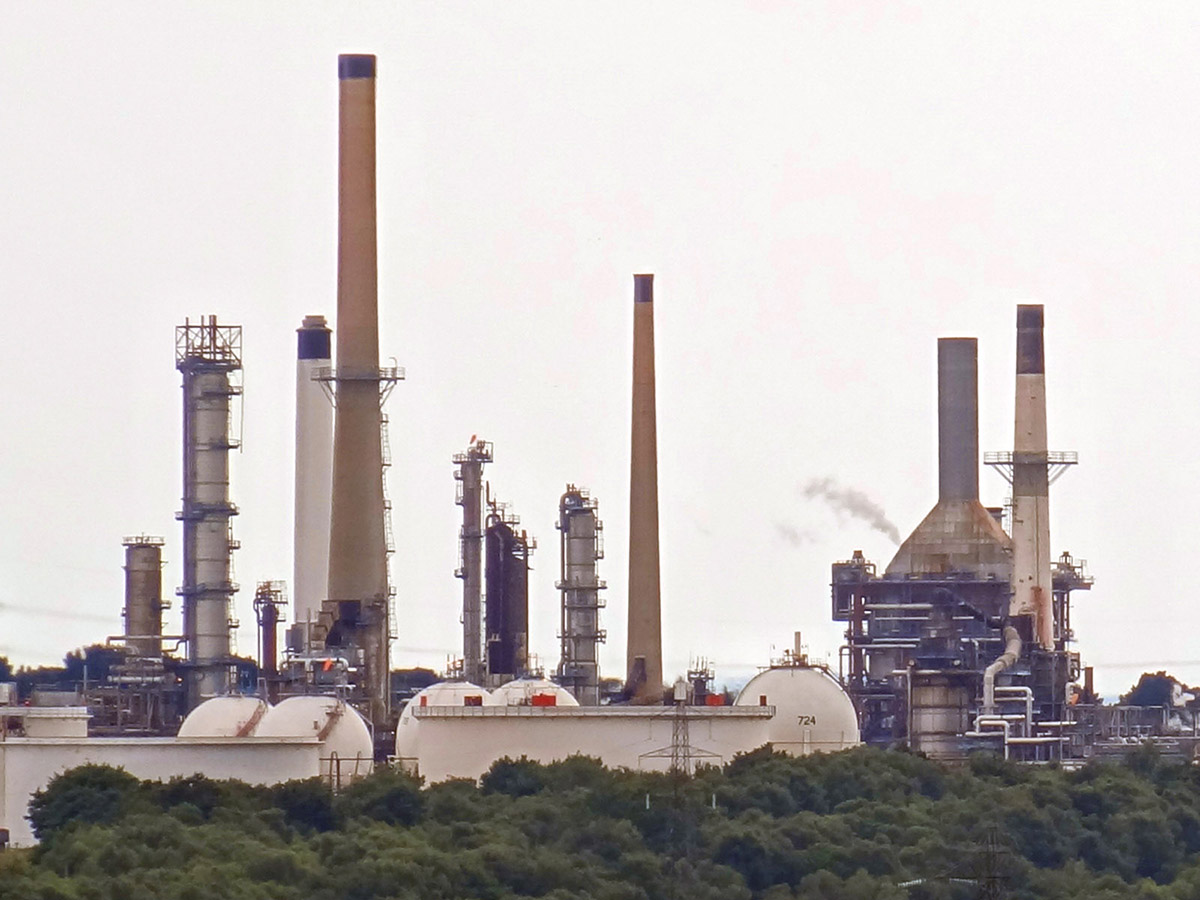 Global oil prices (Brent crude) reached $128 per barrel on 9 March, a level not seen for 10 years and surpassed only in the run up to the financial crisis in 2008. Oil prices are determined by global demand and supply, and the current surge in prices is no exception.
Global oil prices (Brent crude) reached $128 per barrel on 9 March, a level not seen for 10 years and surpassed only in the run up to the financial crisis in 2008. Oil prices are determined by global demand and supply, and the current surge in prices is no exception.
A rise in demand and/or a fall in supply will lead to a rise in the price. Given that both demand and supply are relatively price inelastic, such shifts can cause large rises in oil prices. Similarly, a fall in demand or rise in supply can lead to a large fall in oil prices.
These changes are then amplified by speculation. Traders try to get ahead of price changes. If people anticipate that oil prices will rise, they will buy now, or make a contract to buy more in the future at prices quoted today by buying on the oil futures market. This then pushes up both spot (current) prices and futures prices. If demand or supply conditions change, speculation will amplify the reaction to such a change.
What has happened since 2019?
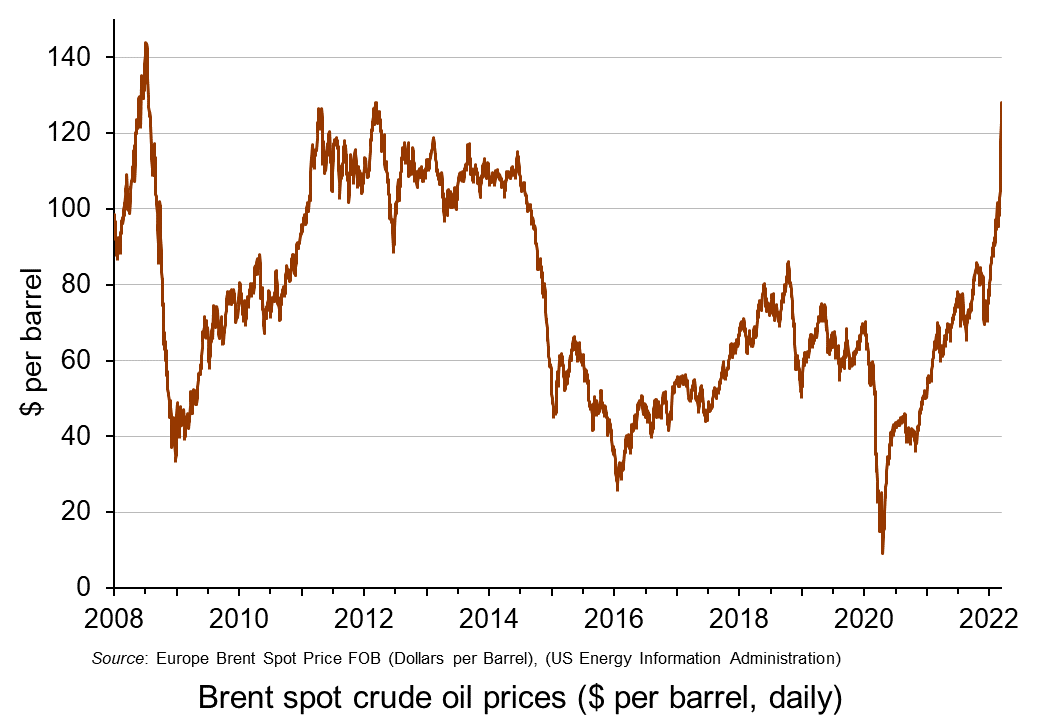 In 2019, oil was typically trading at around $60 to $70 per barrel. It then fell dramatically in early 2020 as the onset of COVID-19 led to a collapse in demand, for both transport and industry. The price fell below $20 in late April (see charts: click here for a PowerPoint).
In 2019, oil was typically trading at around $60 to $70 per barrel. It then fell dramatically in early 2020 as the onset of COVID-19 led to a collapse in demand, for both transport and industry. The price fell below $20 in late April (see charts: click here for a PowerPoint).
Oil prices then rose rapidly as demand recovered somewhat but supply chains, especially shipping, were suffering disruptions. By mid-2021, oil was once more trading at around $60 to $70 per barrel. But then demand grew more strongly as economic recovery from COVID accelerated. But supply could not grow so quickly. By January 2022, Brent crude had risen above $80 per barrel.
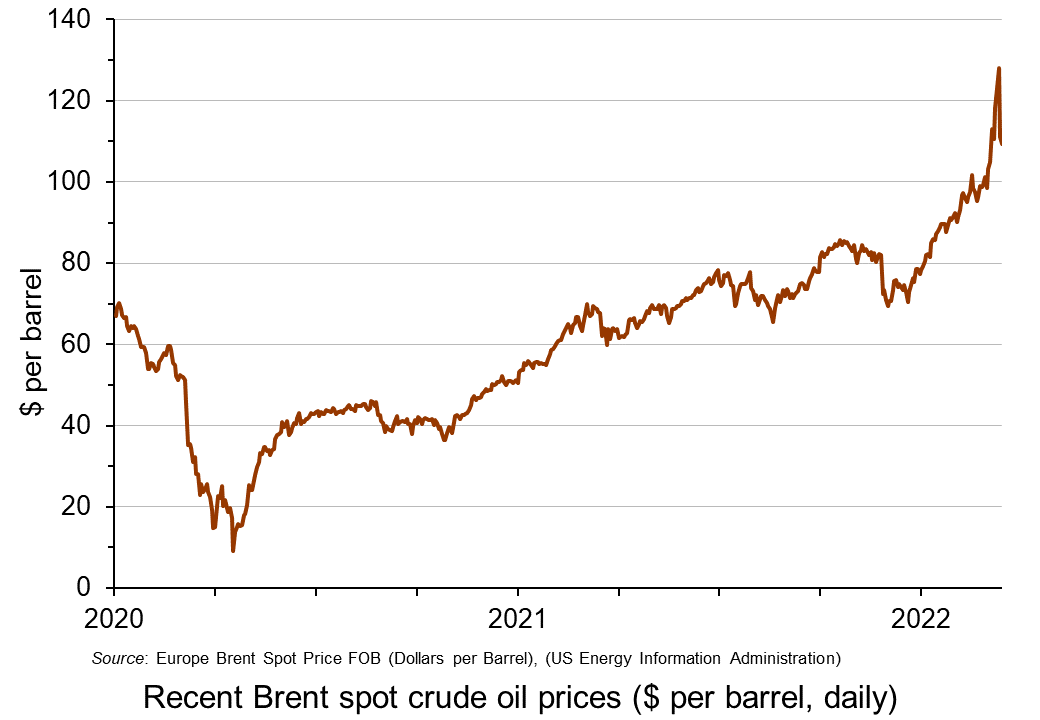 Then worries began to grow about Russian intentions over Ukraine as Russia embarked on large-scale military exercises close to the border with Ukraine. People increasingly disbelieved Russia’s declarations that it had no intention to invade. Russia is the world’s second biggest producer of oil and people feared that deliberate disruptions to supply by Russia or other countries banning imports of Russian oil would cause supply shortages. Speculation thus drove up the oil price. By 23 February, the day before the Russian invasion of Ukraine, Brent crude had risen to $95.
Then worries began to grow about Russian intentions over Ukraine as Russia embarked on large-scale military exercises close to the border with Ukraine. People increasingly disbelieved Russia’s declarations that it had no intention to invade. Russia is the world’s second biggest producer of oil and people feared that deliberate disruptions to supply by Russia or other countries banning imports of Russian oil would cause supply shortages. Speculation thus drove up the oil price. By 23 February, the day before the Russian invasion of Ukraine, Brent crude had risen to $95.
With the Russian invasion, moves were made by the EU the USA and other countries to ban or limit the purchase of Russian oil. This increased the demand for non-Russian oil.
 On 8 March, the USA announced that it was banning the import of Russian oil with immediate effect. The same day, the UK announced that it would phase out the import of Russian oil and oil products by the end of 2022.
On 8 March, the USA announced that it was banning the import of Russian oil with immediate effect. The same day, the UK announced that it would phase out the import of Russian oil and oil products by the end of 2022.
The EU is much more dependent on Russian oil imports, which account for around 27% of EU oil consumption and 2/3 of extra-EU oil imports. Nevertheless, it announced that it would accelerate the move away from Russian oil and gas and towards green alternatives. By 8 March, Brent crude had risen to $128 per barrel.
The question was then whether other sources of supply would help to fill the gap. Initially it seemed that OPEC+ (excluding Russia) would not increase production beyond the quotas previously agreed by the cartel to meet recovery in world demand. But then, on 9 March, the UAE Ambassador to Washington announced that the county favoured production increases and would encourage other OPEC members to follow suit. With the announcement, the oil price fell by 11% to £111. But the next day, it rose again somewhat as the UAE seemed to backtrack, but then fell back slightly as OPEC said there was no shortage of oil.
This is obviously an unfolding story with the suffering of the Ukrainian people at its heart. But the concepts of supply and demand and their price elasticity and the role of speculation are central to understanding what will happen to oil prices in the coming months with all the consequences for poverty and economic hardship.
Articles
Data
Questions
- Use a demand and supply diagram to illustrate what has happened to oil prices over the past two years. How has the size of the effects been dependent on the price elasticity of demand for oil and the price elasticity of supply of oil?
- Use a demand and supply diagram to show what has been happening to the price of natural gas over the past two years. Are the determinants similar to those in the oil market? How do they differ (if at all)?
- What policy options are open to governments to deal with soaring energy prices?
- What are the distributional consequences of the rise in energy prices? (see the blog: Rise in the cost of living.)
- Under what circumstances are oil prices over the next six months likely (a) fall; (b) continue rising?
 The suffering inflicted on the Ukrainian people by the Russian invasion is immense. But, at a much lower level, the war will also inflict costs on people in countries around the world. There will be significant costs to households in the form of even higher energy and food price inflation and a possible economic slowdown. The reactions of governments and central banks could put a further squeeze on living standards. Stock markets could fall further and investment could decline as firms lose confidence.
The suffering inflicted on the Ukrainian people by the Russian invasion is immense. But, at a much lower level, the war will also inflict costs on people in countries around the world. There will be significant costs to households in the form of even higher energy and food price inflation and a possible economic slowdown. The reactions of governments and central banks could put a further squeeze on living standards. Stock markets could fall further and investment could decline as firms lose confidence.
Russia is the world’s second largest oil supplier and any disruption to supplies will drive up the price of oil significantly. Ahead of the invasion, oil prices were rising. At the beginning of February, Brent crude was around $90 per barrel. With the invasion, it rose above $100 per barrel.
 Russia is also a major producer of natural gas. The EU is particularly dependent on Russia, which supplies 40% of its natural gas. With Germany halting approval of the major new gas pipeline under the Baltic from Russia to Germany, Nord Stream 2, the price of gas has rocketed. On the day of the invasion, European gas prices rose by over 50%.
Russia is also a major producer of natural gas. The EU is particularly dependent on Russia, which supplies 40% of its natural gas. With Germany halting approval of the major new gas pipeline under the Baltic from Russia to Germany, Nord Stream 2, the price of gas has rocketed. On the day of the invasion, European gas prices rose by over 50%.
Nevertheless, with the USA deciding not to extend sanctions to Russia’s energy sector, the price of gas fell back by 32% the next day. It remains to be seen just how much the supplies of oil and gas from Russia will be disrupted over the coming weeks.
Both Russia and Ukraine are major suppliers of wheat and maize, between them responsible for 14% of global wheat production and 30% of global wheat exports. A significant rise in the price of wheat and other grains will exacerbate the current rise in food price inflation.
Russia is also a significant supplier of metals, such as copper, platinum, aluminium and nickel, which are used in a wide variety of products. A rise in their price has begun and will further add to inflationary pressures and supply-chain problems which have followed the pandemic.
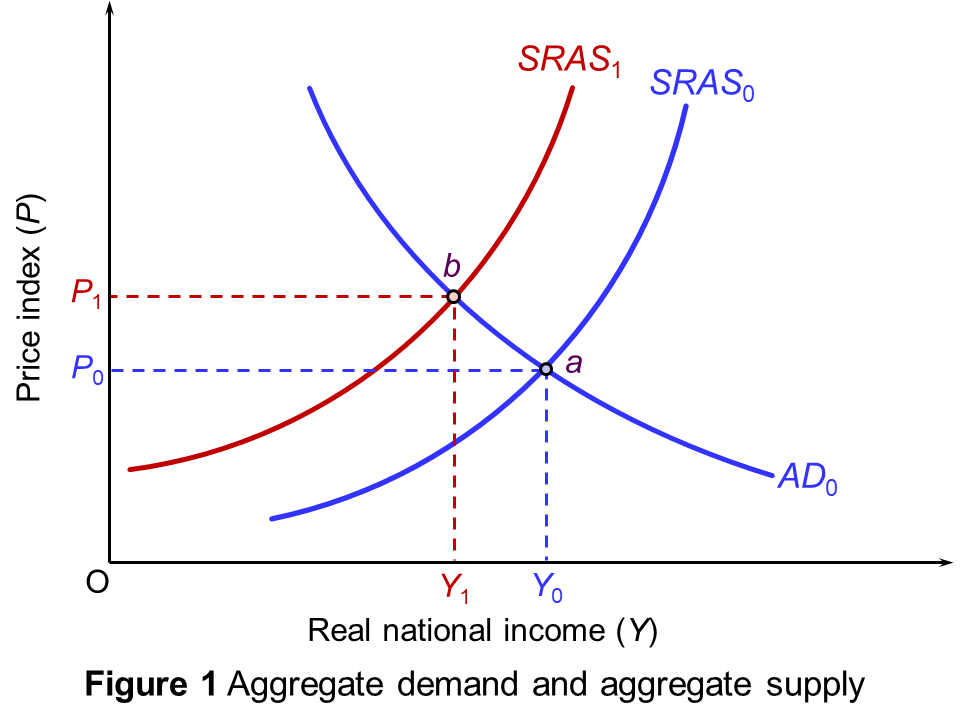 The effect of these supply shocks can be illustrated in a simple aggregate demand and supply diagram (see Figure 1), which shows a representative economy that imports energy, grain and other resources. Aggregate demand and short-run aggregate supply are initially given by AD0 and SRAS0. Equilibrium is at point a, with real national income (real GDP) of Y0 and a price index of P0.
The effect of these supply shocks can be illustrated in a simple aggregate demand and supply diagram (see Figure 1), which shows a representative economy that imports energy, grain and other resources. Aggregate demand and short-run aggregate supply are initially given by AD0 and SRAS0. Equilibrium is at point a, with real national income (real GDP) of Y0 and a price index of P0.
The supply shock shifts short-run aggregate supply to SRAS1. Equilibrium moves to point b. The price index rises to P1 and real national income falls to Y1. If it is a ‘one-off’ cost increase, then the price index will settle at the new higher level and GDP at the new lower level provided that real aggregate demand remains the same. Inflation will be temporary. If, however, the SRAS curve continues to shift upwards to the left, then cost-push inflation will continue.
These supply-side shocks make the resulting inflation hard for policymakers to deal with. When the problem lies on the demand side, where the inflation is accompanied by an unsustainable boom, a contractionary fiscal and monetary policy can stabilise the economy and reduce inflation. But the inflationary problem today is not demand-pull inflation; it’s cost-push inflation. Disruptions to supply are both driving up prices and causing an economic slowdown – a situation of ‘stagflation’, or even an inflationary recession.
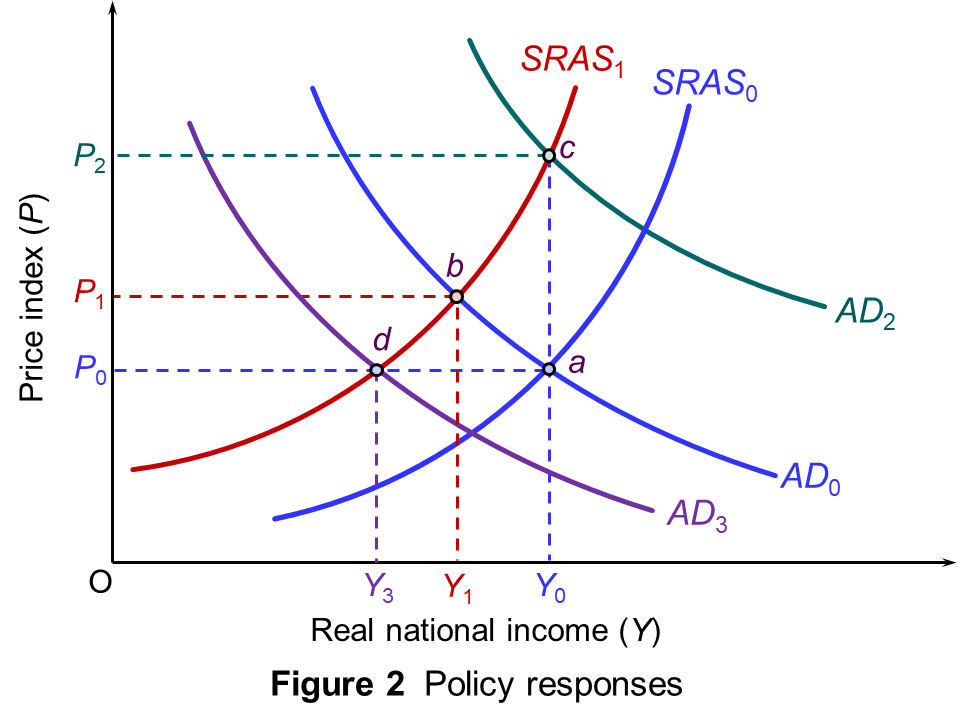 An expansionary policy, such as increasing bond purchases (quantitative easing) or increasing government spending, may help to avoid recession (at least temporarily), but will only exacerbate inflation. In Figure 2, aggregate demand shifts to AD2. Equilibrium moves to point c. Real GDP returns to Y0 (at least temporarily) but the price level rises further, to P2. (Click here for a PowerPoint of the diagram.)
An expansionary policy, such as increasing bond purchases (quantitative easing) or increasing government spending, may help to avoid recession (at least temporarily), but will only exacerbate inflation. In Figure 2, aggregate demand shifts to AD2. Equilibrium moves to point c. Real GDP returns to Y0 (at least temporarily) but the price level rises further, to P2. (Click here for a PowerPoint of the diagram.)
A contractionary policy, such as raising interest rates or taxes, may help to reduce inflation but will make the slowdown worse and could lead to recession. In the diagram, aggregate demand shifts to AD3. Equilibrium moves to point d. The price level returns to P0 (at least temporarily) but real income falls further, to Y3.
In other words, you cannot tackle both the slowdown/recession and the inflation simultaneously by the use of demand-side policy. One requires an expansionary fiscal and/or monetary policy; the other requires fiscal and/or monetary tightening.
Then there are other likely economic stresses. If NATO countries respond by increasing defence expenditure, this will put further strain on public finances.
Sentiment is a key driver of the economy and prices. Expectations tend to be self-fulfilling. So if the war in Ukraine undermines confidence in stock markets and the real economy and further raises inflationary expectations, this pessimistic mood will tend in itself to drive down share prices, drive up inflation and drive down investment and economic growth.
Articles
- How will Russia’s invasion of Ukraine hit the global economy?
Financial Times, Chris Giles, Jonathan Wheatley and Valentina Romei (25/2/22)
- Ukraine conflict raises the possibility of stagflation
Financial Times, The Editorial Board (25/2/22)
- Five ways the Ukraine war could push up prices
BBC News, Laura Jones (5/3/22)
- Jason Furman cautions against reading too much into the initial market reactions to Russia’s invasion
interest.co.nz, Jason Furman (26/2/22)
- Putin’s war promises to crush the global economy with inflation and much slower growth
Market Watch, Nouriel Roubini (25/2/22)
- Roubini: 6 Financial, Economic Risks of Russia-Ukraine War
ThinkAdvisor, Janet Levaux (25/2/22)
- Fed tightening plans now contending with war, possible oil shock
Reuters, Howard Schneider and Jonnelle Marte (24/2/22)
- The invasion of Ukraine changed everything for Wall Street
CNN, Julia Horowitz (27/2/22)
- Why the Russian invasion will have huge economic consequences for American families
CNN, Matt Egan (24/2/22)
- European gas prices soar and oil tops $105 after Russia attacks Ukraine
Financial Times, Neil Hume, Emiko Terazono and Tom Wilson (24/2/22)
- Five essential commodities that will be hit by war in Ukraine
The Conversation, Sarah Schiffling and Nikolaos Valantasis Kanellos (24/2/22)
- Ukraine: ‘I’m surprised the oil price hasn’t hit US$130 a barrel yet’ – energy trading expert Q&A
The Conversation, Adi Imsirovic (25/2/22)
- Ukraine crisis: Warning UK energy bills could top £3,000 a year
BBC News, Michael Race (25/2/22)
- Putin’s energy shock: The economic realities of invasion
BBC News, Faisal Islam (25/2/22)
- Fears of UK food and fuel prices rising due to war
BBC News, Oliver Smith & Michael Race (26/2/22)
- Ukraine conflict: What is Swift and why is banning Russia so significant?
BBC News, Russell Hotten (27/2/22)
- Ukraine conflict: How reliant is Europe on Russia for oil and gas?
BBC News, Jake Horton & Daniele Palumbo (25/2/22)
- Ukraine crisis complicates ECB’s path to higher rates
Reuters, Francesco Canepa and Balazs Koranyi (24/2/22)
- Russia and the West are moving towards all out economic war
Al Jazeera, Maximilian Hess (24/2/22)
Questions
- If there is a negative supply shock, what will determine the size of the resulting increase in the price level and the rate of inflation over the next one or two years?
- How may expectations affect (a) the size of the increase in the price level; (b) future prices of gas and oil?
- Why did stock markets rise on the day after the invasion of Ukraine?
- Argue the case for and against relaxing monetary policy and delaying tax rises in the light of the economic consequences of the war in Ukraine.
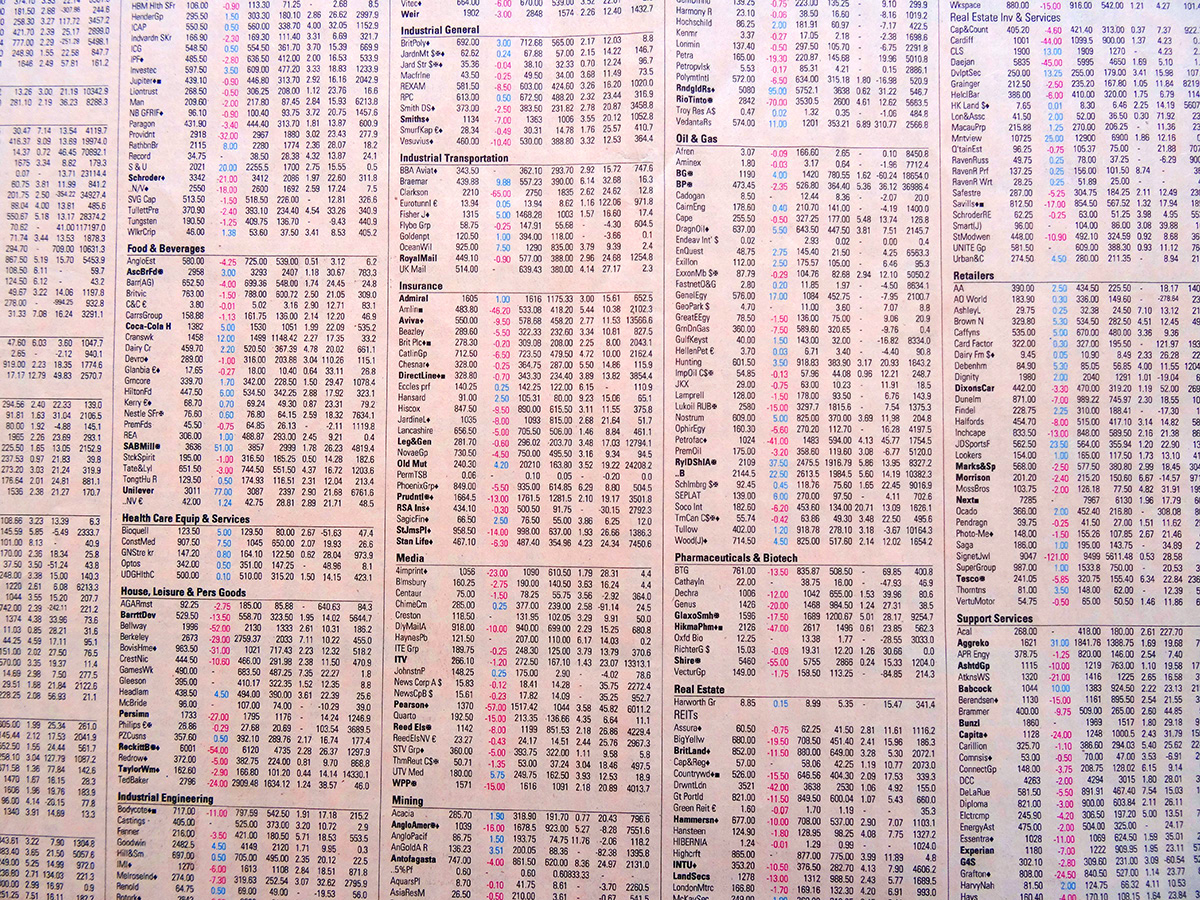 With the onset of the pandemic in early 2020, stock markets around the world fell dramatically, with many indices falling by 30% or more. In the USA, the Dow Jones fell by 37% and the Nasdaq fell by 30%. In the UK, the FTSE 100 fell by 33% and the FTSE 250 by 41%.
With the onset of the pandemic in early 2020, stock markets around the world fell dramatically, with many indices falling by 30% or more. In the USA, the Dow Jones fell by 37% and the Nasdaq fell by 30%. In the UK, the FTSE 100 fell by 33% and the FTSE 250 by 41%.
But with a combination of large-scale government support for their economies, quantitative easing by central banks and returning confidence of investors, stock markets then made a sustained recovery and have continued to grow strongly since – until recently, that is.
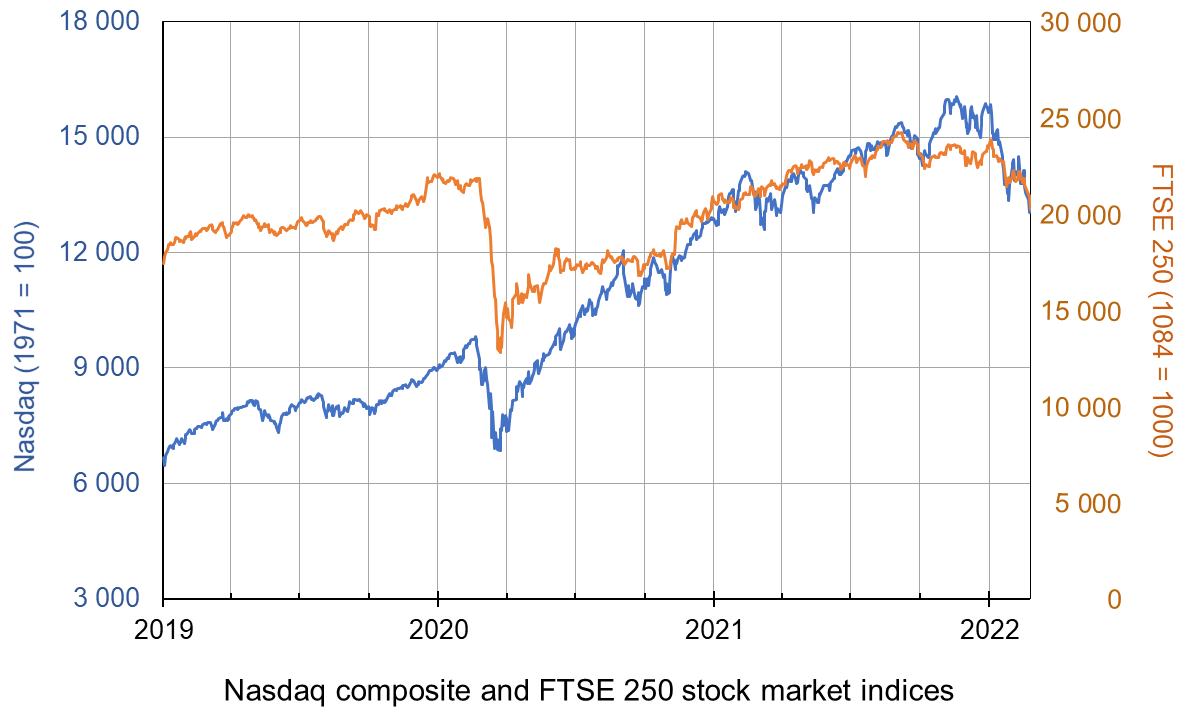
With inflation well above target levels, central banks have ended quantitative easing (QE) or have indicated that they soon will. Interest rates are set to rise, if only slowly. The Bank of England raised Bank Rate from its historic low of 0.1% to 0.25% on 16 December 2021 and ceased QE, having reached its target of £895 billion of asset purchases. On 4 February 2022, it raised Bank Rate to 0.5%. The Fed has announced that it will gradually raise interest rates and will end QE in March 2022, and later in the year could begin selling some of the assets it has purchased (quantitative tightening). The ECB is not ending QE or raising interest rates for the time being, but is likely to do so later in the year.
At the same time economic growth is slowing, leading to fears of stagflation. Governments are likely to dampen growth further by tightening fiscal policy. In the UK, national insurance is set to rise by 1.25 percentage points in April.
The slowdown in growth may discourage central banks from tightening monetary policy more than very slightly. Indeed, in the light of its slowing economy, the Chinese central bank cut interest rates on 20 January 2022. Nevertheless, it is likely that the global trend will be towards tighter monetary policy.
The fears of slowing growth and tighter monetary and fiscal policy have led many stock market investors to predict an end to the rise in stock market prices – an end to the ‘bull run’. This belief was reinforced by growing tensions between Russia and NATO countries and fears (later proved right) that Russia might invade Ukraine with all the turmoil in the global economy that this would entail. Stock market prices have thus fallen.
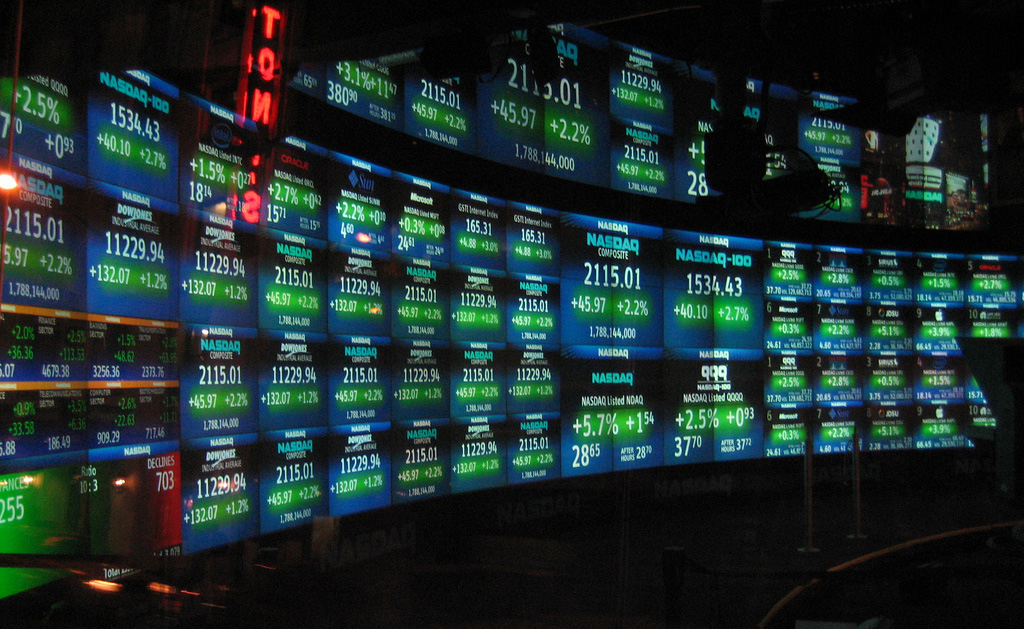 The key question is what will investors believe. If they believe that share prices will continue to fall they are likely to sell. This has happened since early January, especially in the USA and especially with stocks in the high-tech sector – such stocks being heavily represented in the Nasdaq composite, a broad-based index that includes over 2500 of the equities listed on the Nasdaq stock exchange. From 3 January to 18 February the index fell from 15 833 to 13 548, a fall of 14.4%. But will this fall be seen as enough to reflect the current economic and financial climate. If so, it could fluctuate around this sort of level.
The key question is what will investors believe. If they believe that share prices will continue to fall they are likely to sell. This has happened since early January, especially in the USA and especially with stocks in the high-tech sector – such stocks being heavily represented in the Nasdaq composite, a broad-based index that includes over 2500 of the equities listed on the Nasdaq stock exchange. From 3 January to 18 February the index fell from 15 833 to 13 548, a fall of 14.4%. But will this fall be seen as enough to reflect the current economic and financial climate. If so, it could fluctuate around this sort of level.
However, some may speculate that the fall has further to go – that indices are still too high to reflect the earning potential of companies – that the price–earnings ratio is still too high for most shares. If this is the majority view, share prices will indeed fall.
Others may feel that 14.4% is an overcorrection and that the economic climate is not as bleak as first thought and that the Omicron coronavirus variant, being relatively mild for most people, especially if ‘triple jabbed’, may do less economic damage than first feared. In this scenario, especially if the tensions over Ukraine are diffused, people are likely to buy shares while they are temporarily low.
 But a lot of this is second-guessing what other people will do – known as a Keynesian beauty contest situation. If people believe others will buy, they will too and this will push share prices up. If they think others will sell, they will too and this will push share prices down. They will all desperately wish they had a crystal ball as they speculate how people will interpret what central banks, governments and other investors will do.
But a lot of this is second-guessing what other people will do – known as a Keynesian beauty contest situation. If people believe others will buy, they will too and this will push share prices up. If they think others will sell, they will too and this will push share prices down. They will all desperately wish they had a crystal ball as they speculate how people will interpret what central banks, governments and other investors will do.
Articles
Questions
- What changes in real-world factors would drive investors to (a) buy (b) sell shares at the current time?
- How does quantitative easing affect share prices?
- What is meant by the price-earnings ratio of a share? Is it a good indicator as to the likely movement of that share’s price? Explain.
- What is meant by a Keynesian beauty contest? How is it relevant to the stock market?
- Distinguish between stabilising and destabilising speculation and illustrate each with a demand and supply diagram. Explain the concept of overshooting in this context.
- Which is more volatile, the FTSE 100 or the FTSE 250? Explain.
- Read the final article linked above. Were the article’s predictions about the Fed meeting on 26 January borne out? Comment.
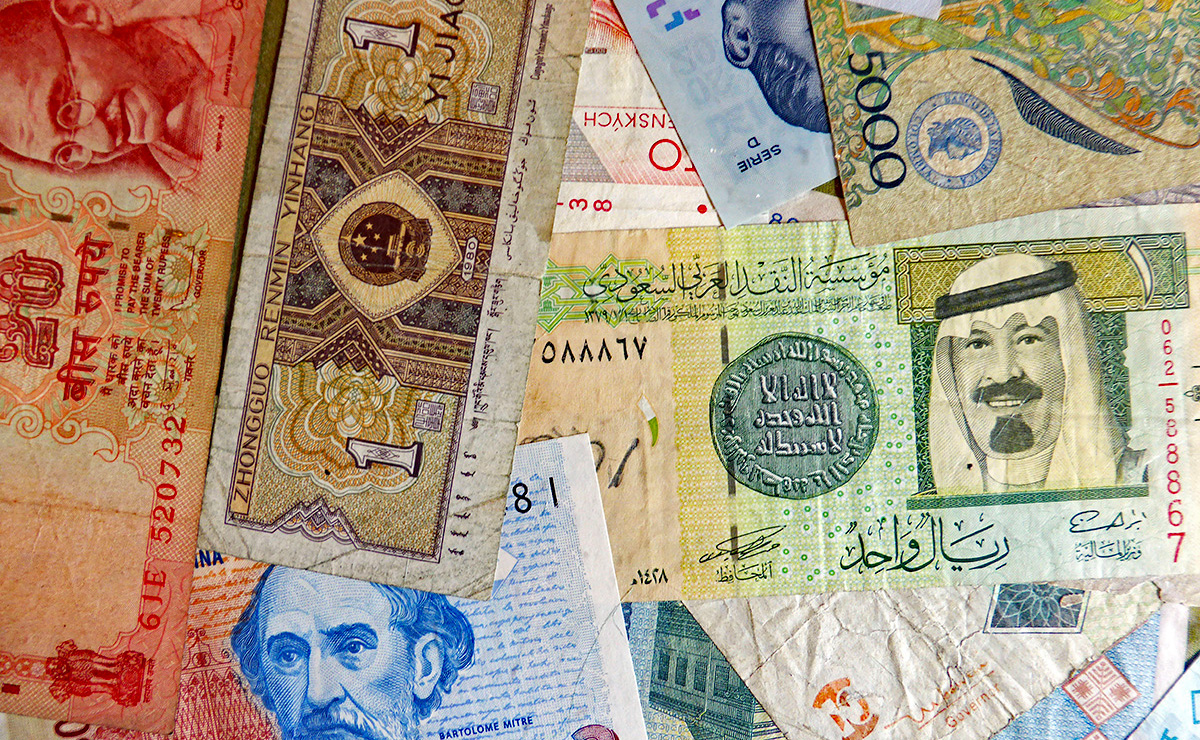 Inflation has been rising around the world as a combination of a recovery in demand and supply-chain issues have resulted in aggregate demand exceeding aggregate supply. Annual consumer price inflation at the beginning of 2022 is around 2.5% in China, 3.5% in Sweden, 5% in the eurozone, Canada and India, 6% in the UK and South Africa, 7% in the USA and 7.5% in Mexico. In each case it is forecast to go a little higher before falling back again.
Inflation has been rising around the world as a combination of a recovery in demand and supply-chain issues have resulted in aggregate demand exceeding aggregate supply. Annual consumer price inflation at the beginning of 2022 is around 2.5% in China, 3.5% in Sweden, 5% in the eurozone, Canada and India, 6% in the UK and South Africa, 7% in the USA and 7.5% in Mexico. In each case it is forecast to go a little higher before falling back again.
Inflation in Turkey
In Turkey inflation is much higher. The official annual rate of consumer price inflation in December 2021 was 36.1%, sharply up from 21.3% in November. But according to Turkey’s influential ENAGrup the December rate was much higher still at 82.8%. Official producer price inflation was 79.9% and this will feed through into official consumer price inflation in the coming weeks.
The rise in inflation has hit the poor particularly badly. According to the official statistics, in the year to December 2021, domestic energy prices increased by 34.2%, food by 44.7% and transport by 53.7%. In response, the government has raised the minimum wage by nearly 50% for 2022.
Causes of high and rising inflation
 Why is Turkey’s inflation so much higher than in most developed and emerging economies and why has it risen so rapidly? The answer is that aggregate demand has been excessively boosted – well ahead of the ability of supply to respond. This has driven inflation expectations.
Why is Turkey’s inflation so much higher than in most developed and emerging economies and why has it risen so rapidly? The answer is that aggregate demand has been excessively boosted – well ahead of the ability of supply to respond. This has driven inflation expectations.
Turkey’s leader, President Erdoğan, in recent years has been seeking to stimulate economic growth through a mixture of supply-side, fiscal and monetary policies. He has hoped that the prospect of high growth would encourage both domestic and inward investment and that this would indeed drive the high growth he seeks. To encourage investment he has sought to reduce the reliance on imports through various measures, such as public procurement favouring domestic firms, tax reliefs for business and keeping interest rates down. He has claimed that the policy is focused on investment, production, employment and exports, instead of the ‘vicious circle of high interest rates and low exchange rates’.
With the pandemic, fiscal policy was largely focused on health, social security and employment measures. Such support was aided by a relatively healthy public finances. General government debt was 32% of GDP in 2020. This compares with 74% for the EU and 102% for the G7. Nevertheless, the worsening budget deficit has made future large-scale expenditure on public infrastructure, tax cuts for private business and other supply-side measures more difficult. Support for growth has thus fallen increasingly to monetary policy.
The Turkish central bank is not independent, with the President firing senior officials with whom he disagrees over monetary policy. The same applies to the Finance Ministry, with independently-minded ministers losing their jobs. Monetary and exchange rate policy have thus become the policy of the President. And it is here that a major part of the current problem of rising inflation lies.
Monetary and exchange rate policy
Despite rising inflation, the central bank has reduced interest rates. At its monthly meeting in September 2021, the Turkish central bank reduced its key rate from 19% to 18% and then to 16% in October, to 15% in November and 14% in December. These unprecedented rate cuts saw a large increase in the money supply. M1 rose by 11.7% in November alone; the annual growth rate was 59.5%. Broad money (M2 and M3) similarly rose. M3 grew by an annual rate of 51% in November 2021. The cut in interest rates and rise in money supply led to a rise in nominal expenditure which, in turn, led to higher prices.
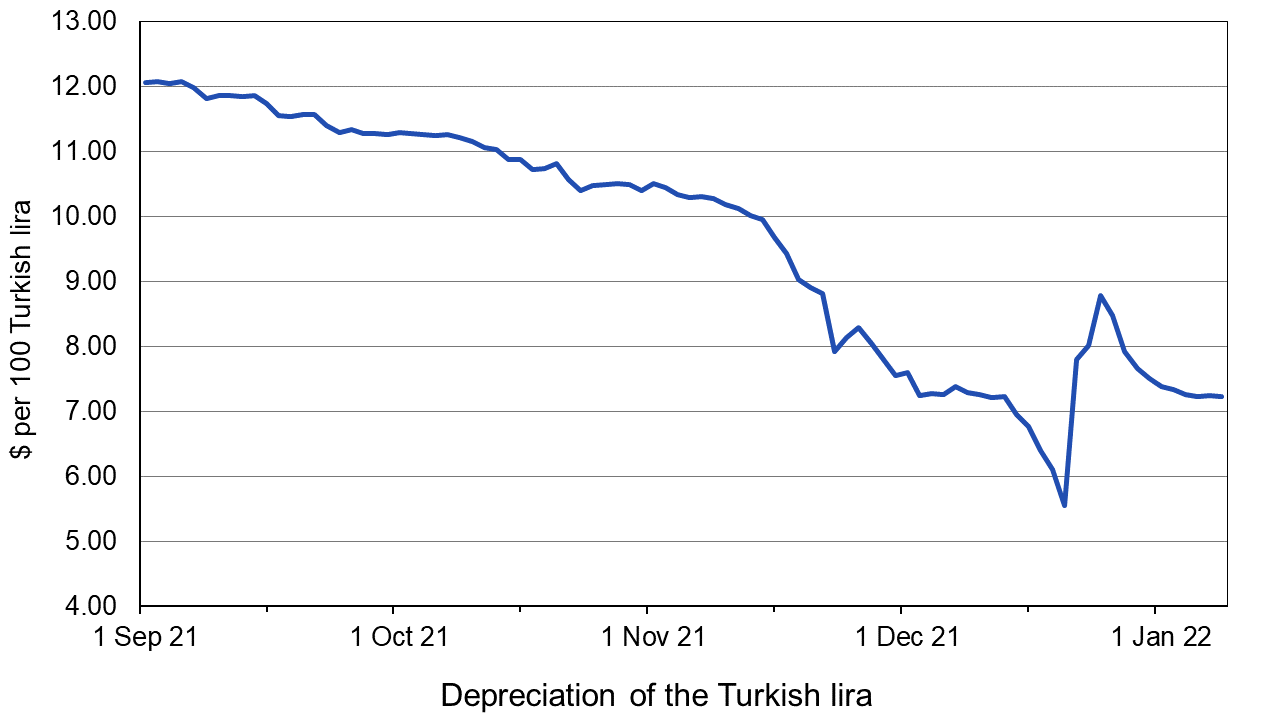
The cut in interest rates and rise in nominal aggregate demand led to a large depreciation in the exchange rate. On 1 September 2021, 100 Turkish lira exchanged for $12.05. By 11 January 2022 the rate had fallen to $7.22 – a 40.1% depreciation. This depreciation, in turn, further stoked inflation as the lower exchange rate pushed up the price of imported goods. (Click here for a PowerPoint of the chart.)
Attempts were made to stem this fall in the lira on 20 December, by which point 100 lira were trading for just $5.50 (see chart) and speculation against the lira was gathering momentum. President Erdoğan announced a scheme to protect lira deposits against currency volatility, guaranteeing lira deposits in hard currency terms. The mechanism adopted was a rise in the interest rate on lira deposits with a maturity of 3 to 12 months, thereby encouraging people to lock in deposits for the medium term and not, therefore, to use them to speculate against the lira by buying other currencies. Other interest rates would be unaffected. At the same time the central bank used foreign currency reserves to engage in large-scale purchases of the lira on the foreign exchange market.
The lira rallied. By 23 December, 100 lira were trading for $8.79. But then selling of the lira began again and, as stated above, by early January 100 lira had fallen to $7.22. The underlying problem of excess demand and high inflationary expectations had not been solved.
It remains to be seen whether the President will change his mind and decide that the central bank needs to raise interest rates to reduce inflation and restore confidence.
Videos
Articles
- Turkish Inflation Hits Highest Since 2002 Amid Lira Woes
Bloomberg, Baris Balci and Cagan Koc (3/1/22)
- Turkey’s annual inflation rate is over 82 percent, finds research group
Bianet (3/1/22)
- How Turkey can overcome its economic challenges
Arab News, Zaid M Belbagi (2/1/22)
- Turkey cuts interest rates despite spiralling inflation
BBC News, Victoria Craig (16/12/21)
- Turkey inflation surges 36% amid lira crisis, highest since 2002
CNBC (3/1/22)
- Turkey mulls new financial instruments to shield against inflation
Daily Sabah (3/1/22)
- Turkey raises minimum wage as lira crash, inflation sow hardship
Aljazeera, Umar Farooq (16/12/21)
- What to make of Turkey’s latest unorthodox currency move
Financial Times, Mohamed El-Erian (21/12/21)
- Erdoğan gambles on economy amid protests and rocketing inflation
The Guardian, Phillip Inman (24/11/21)
- Explained: How did Turkey’s economy go so wrong?
The Indian Express, Patricia Cohen (15/12/21)
Data
Questions
- Until the pandemic, the Turkish economy could be seen as a success story. Why?
- What supply-side policies did Turkey pursue?
- Use either an aggregate demand and supply diagram or a dynamic aggregate demand and supply (DAD/DAS) diagram to explain what has happened to inflation in Turkey in the past few months.
- Explain the thinking behind the successive cuts in interest rates since September 2021.
- Why did the measures introduced on 20 December 2021 only temporarily halt the depreciation of the lira?
- Choose a country with a higher rate of inflation than Turkey (see second data link above). Find out the causes of its high rate. Are they similar to those in Turkey?
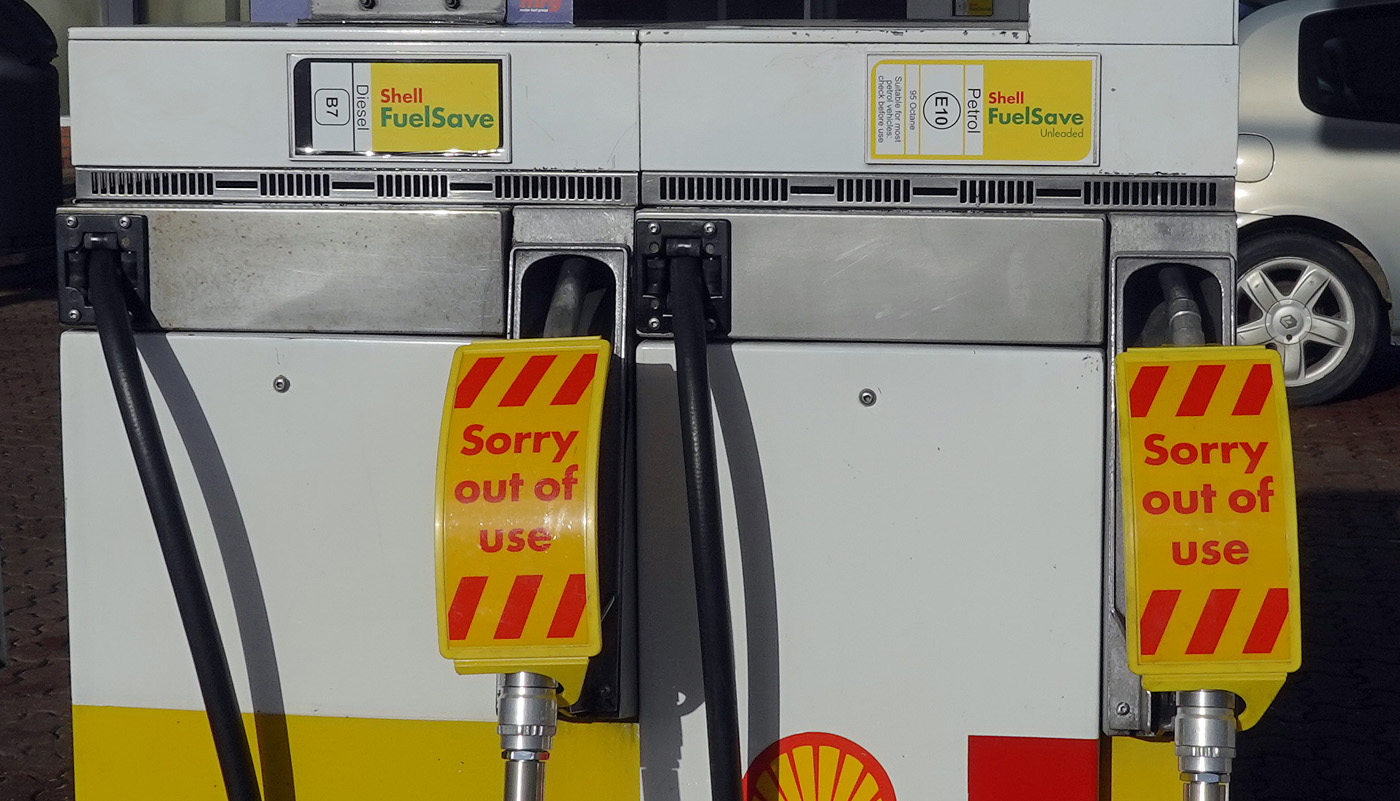 Long queues at petrol pumps, with many filling stations running out of fuel; fears of shortages of food and various other items in supermarkets; orders by shops and warehouses unfilled or delayed. These have been some of the headlines in the UK in recent days.
Long queues at petrol pumps, with many filling stations running out of fuel; fears of shortages of food and various other items in supermarkets; orders by shops and warehouses unfilled or delayed. These have been some of the headlines in the UK in recent days.
The immediate problem is a shortage of over 100 000 lorry drivers, with thousands of drivers from EU countries, who were previously living and working in the UK, having returned to their home countries. Their numbers have not been replaced by British drivers, a problem exacerbated by a decline in HGV tests during the pandemic. Thus the supply of lorry drivers has fallen.
At the same time, as the economy recovers from the COVID-19 pandemic, aggregate demand has risen and with it the demand for lorry drivers.
The shortage is pushing up wages somewhat, but not enough to eliminate the shortage. What is more, the supply of lorry drivers is relatively wage inelastic: a higher wage does not attract many more drivers into the market. Also the demand is also relatively wage inelastic: a higher wage does not do much to dampen the demand for drivers.
But why has this happened? Why has the supply of drivers fallen and why is it inelastic? And what will happen in the coming months? The three main causes are Brexit, COVID-19 and working conditions.
Brexit
 With Brexit, many EU workers left the UK, finding life and working conditions more conducive in the EU. Many EU drivers had faced discrimination and felt that they were not welcome in the UK. It has been difficult finding replacement drivers from the EU as the UK’s immigration system, which now applies to the EU as well as other countries, prioritises workers who are classified as high-skilled, and these do not include lorry drivers.
With Brexit, many EU workers left the UK, finding life and working conditions more conducive in the EU. Many EU drivers had faced discrimination and felt that they were not welcome in the UK. It has been difficult finding replacement drivers from the EU as the UK’s immigration system, which now applies to the EU as well as other countries, prioritises workers who are classified as high-skilled, and these do not include lorry drivers.
Those EU drivers who do want to stay as UK residents are finding that settled status or visas are not easy to achieve and involve filling in various documents, which can be an onerous and time-consuming process. As the writer of the first linked bog below, who is a Polish worker in the transport industry, states, ‘Would you rather come to Britain and jump through all the hoops, or choose any of the well-paying EU countries, for example, Germany that, if you live in Western Poland, is just a short drive across (virtually non-existent thanks to Schengen) border?’ Another problem is that with EU driving licences: it is harder for potential employers to check on their status and thus they may prefer to employ UK drivers. This, again, puts off EU drivers from seeking to stay in the UK.
Even in the case of EU drivers living in the EU but delivering to the UK there are problems. First there are the dangers for drivers of boarding ferries in France, where people from migrant camps seek to board lorries to get passage to the UK, often threatening drivers. If illegal migrants do succeed in boarding a trailer unseen by the driver, the driver can then be arrested in the UK. According to the Polish blogger, it’s ‘no surprise that I hear more and more drivers who, when taking on new jobs, demand guarantees from their employers that they won’t be sent to the UK’.
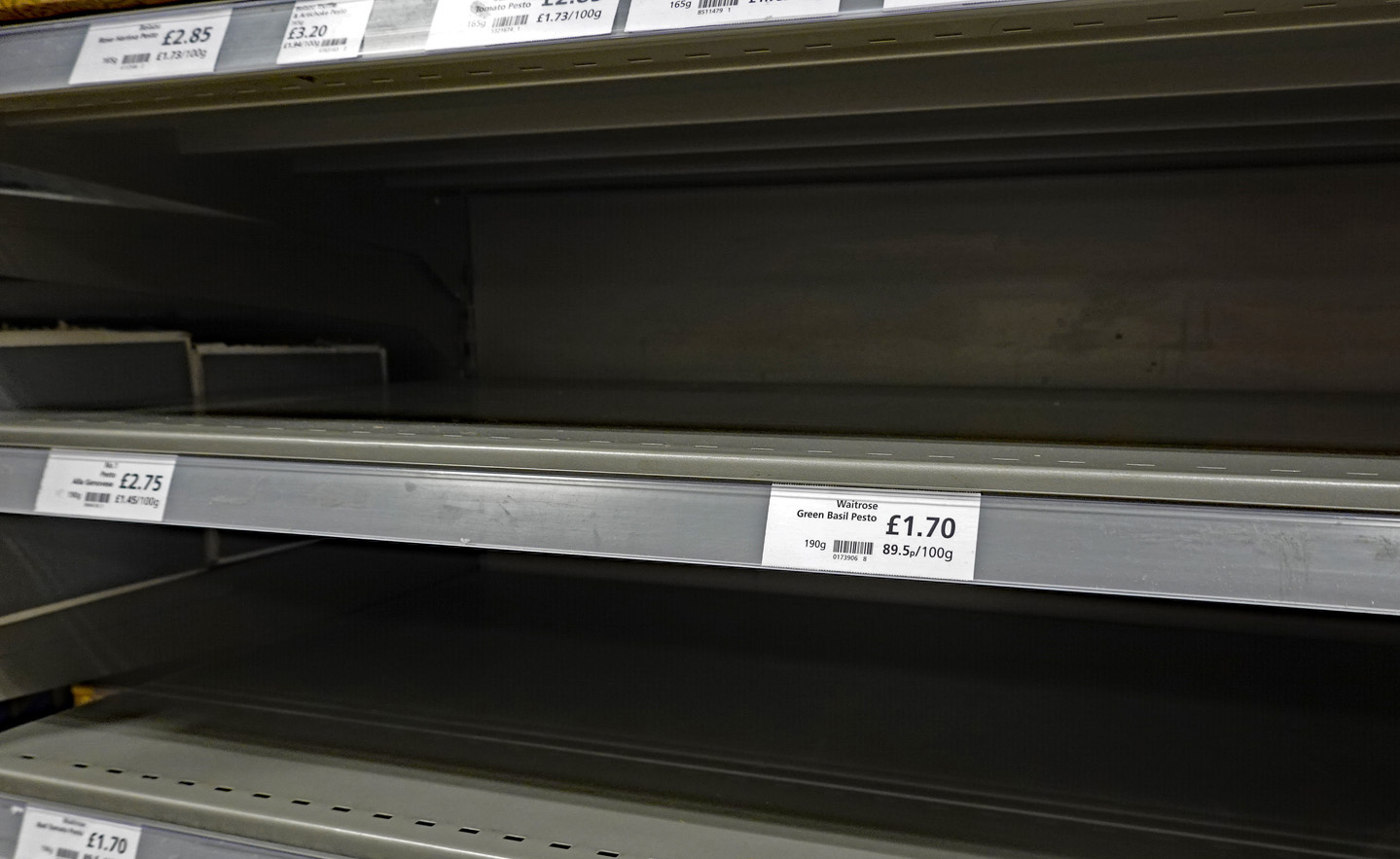 Then there is a decline in the system known as ‘cabotage’. This is where an EU driver delivers from the EU to destination A in the UK and takes back a load to the EU from destination B in the UK. To avoid having to travel empty between the two UK destinations, the driver could pick up a load to take from A to B. With a fall in imports and exports from and to the EU following Brexit, there are fewer EU lorries on UK roads. This means that there is now less capacity for transporting loads within the UK.
Then there is a decline in the system known as ‘cabotage’. This is where an EU driver delivers from the EU to destination A in the UK and takes back a load to the EU from destination B in the UK. To avoid having to travel empty between the two UK destinations, the driver could pick up a load to take from A to B. With a fall in imports and exports from and to the EU following Brexit, there are fewer EU lorries on UK roads. This means that there is now less capacity for transporting loads within the UK.
There has also been a large rise in ‘red tape’ associated with post-Brexit customs checks and border controls. This means that lorries can be held up at ports. This makes it much less attractive for EU haulage companies to export to the UK rather than to other EU countries, where paperwork is minimal. In addition, m many drivers are paid by the length of the journey rather than by the time spent, so delays result in them earning less per hour. Full checks have not been introduced yet. When they are, in January and July next year, the problem will be worse.
Tax changes make it more difficult for drivers to avoid taxes by claiming that they are self employed when they are in reality employees. This too is discouraging drivers from the EU from moving to or staying in the UK since many would now (since April 2021) be paying more tax.
COVID-19
Another contributing factor to the shortage of drivers has been COVID-19 and the government’s response to it. COVID rates are considerably higher in the UK than in most EU countries and, not surprisingly, many EU drivers are afraid to come to the UK.
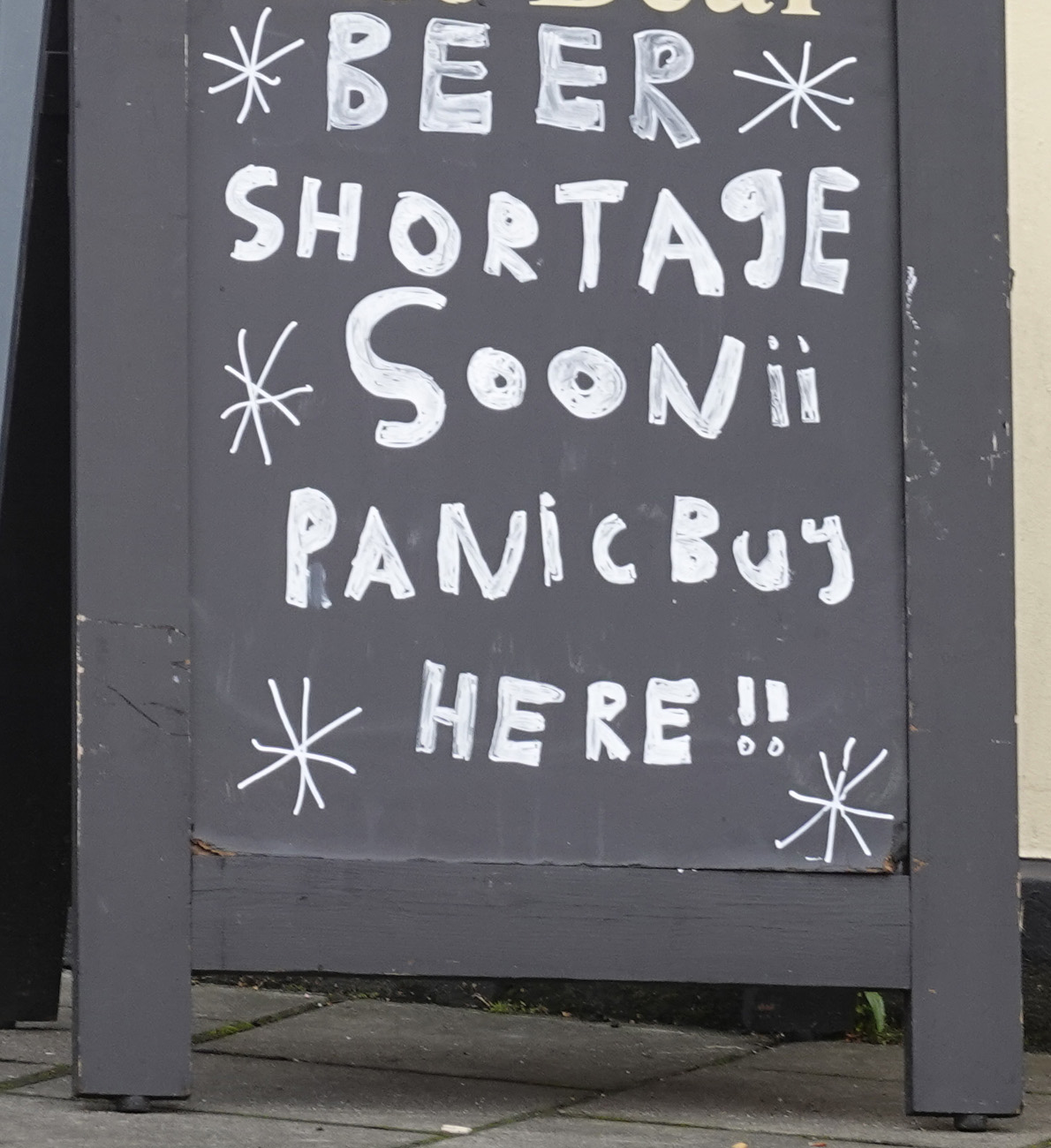 The pandemic led to fewer HGV driver tests, with 25 000 fewer candidates passing their test in 2020 than in 2019. It takes time to train new drivers and then to test them. However, even if there had been no reduction in HGV drivers passing their tests, there would still be a significant shortage of qualified drivers.
The pandemic led to fewer HGV driver tests, with 25 000 fewer candidates passing their test in 2020 than in 2019. It takes time to train new drivers and then to test them. However, even if there had been no reduction in HGV drivers passing their tests, there would still be a significant shortage of qualified drivers.
A further problem with the effects of COVID-19 on the economy has been the initial recession and then the bounce back. The sheer size of the bounce back has exacerbated the problem of driver shortages, which otherwise would have been slower to develop, giving the market more time to respond. Real GDP grew by 5.5% from 2021 Q1 to 2021 Q2, giving an annual growth rate of 23.6%. Nevertheless, GDP was still some 3.3% below its 2019 Q3 level.
Pay and working conditions
Working conditions are very poor for many drivers. The following are common complaints:
 Driving jobs are often very tightly controlled, with computer monitoring and little freedom for the driver. Some cabs have cameras aimed at the drivers so that they can be constantly monitored.
Driving jobs are often very tightly controlled, with computer monitoring and little freedom for the driver. Some cabs have cameras aimed at the drivers so that they can be constantly monitored.- Drivers are subject to very stringent health and safety regulations, such as not being allowed to drive longer than a certain time, even when they are queuing in congested traffic. Whilst many of these regulations are desirable to protect both the public’s and the driver’s safety, they can discourage drivers from entering or staying in the industry. And some regulations are hard to justify on safety grounds (see second linked article below, point 13).
- Just-in-time deliveries at supermarkets, regional distribution centres (warehouses) or factories make timing very important and add considerable stress to drivers who may face abuse if they are late, even though it was not their fault, with their employer perhaps facing a fine. And yet on other occasions they might have to wait a long time to offload if drivers before them have been delayed, and often the conditions in waiting areas are poor with few if any facilities.
- Drivers often feel a lack of respect from employers, trainers and the general public.
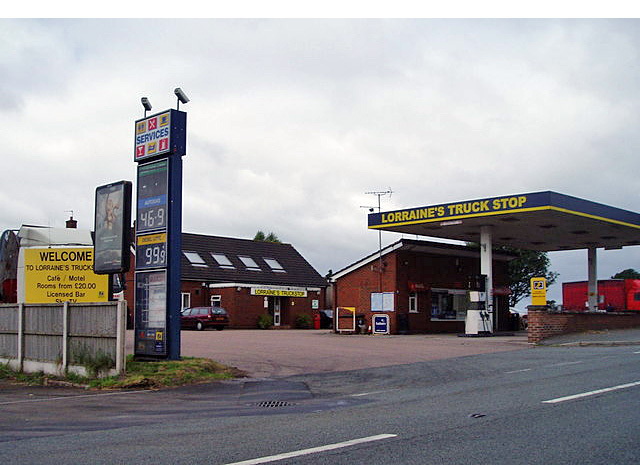 Rest and refreshment facilities are often very poor in the UK and generally much worse than in the EU. In the EU, motorway service areas have better parking, toilets, showers and shops. Restaurants are better and cheaper. Dedicated truck stops have supermarkets, laundrettes, showers or even open-air gyms dedicated to making drivers’ lives easier and more pleasant. The UK by contrast often has very poor facilities. Unlike in most EU motorway services, drivers have to pay to park and are faced with poor toilet and eating facilities. ‘Meanwhile, a typical British truck stop is some dusty yard full of potholes on the side of some industrial estate with a portaloo and a “greasy spoon” burger van parked next to it.’
Rest and refreshment facilities are often very poor in the UK and generally much worse than in the EU. In the EU, motorway service areas have better parking, toilets, showers and shops. Restaurants are better and cheaper. Dedicated truck stops have supermarkets, laundrettes, showers or even open-air gyms dedicated to making drivers’ lives easier and more pleasant. The UK by contrast often has very poor facilities. Unlike in most EU motorway services, drivers have to pay to park and are faced with poor toilet and eating facilities. ‘Meanwhile, a typical British truck stop is some dusty yard full of potholes on the side of some industrial estate with a portaloo and a “greasy spoon” burger van parked next to it.’- Hours are long. Even though driving hours are restricted to 10 hours per day (recently extended to 11 hours), the average working day may be much longer as drivers have to wait at distribution centres, fill in increasing amounts of paperwork and help load or unload their vehicle. Also drivers may have to work variable shifts, which leads to disturbed sleeping patterns.
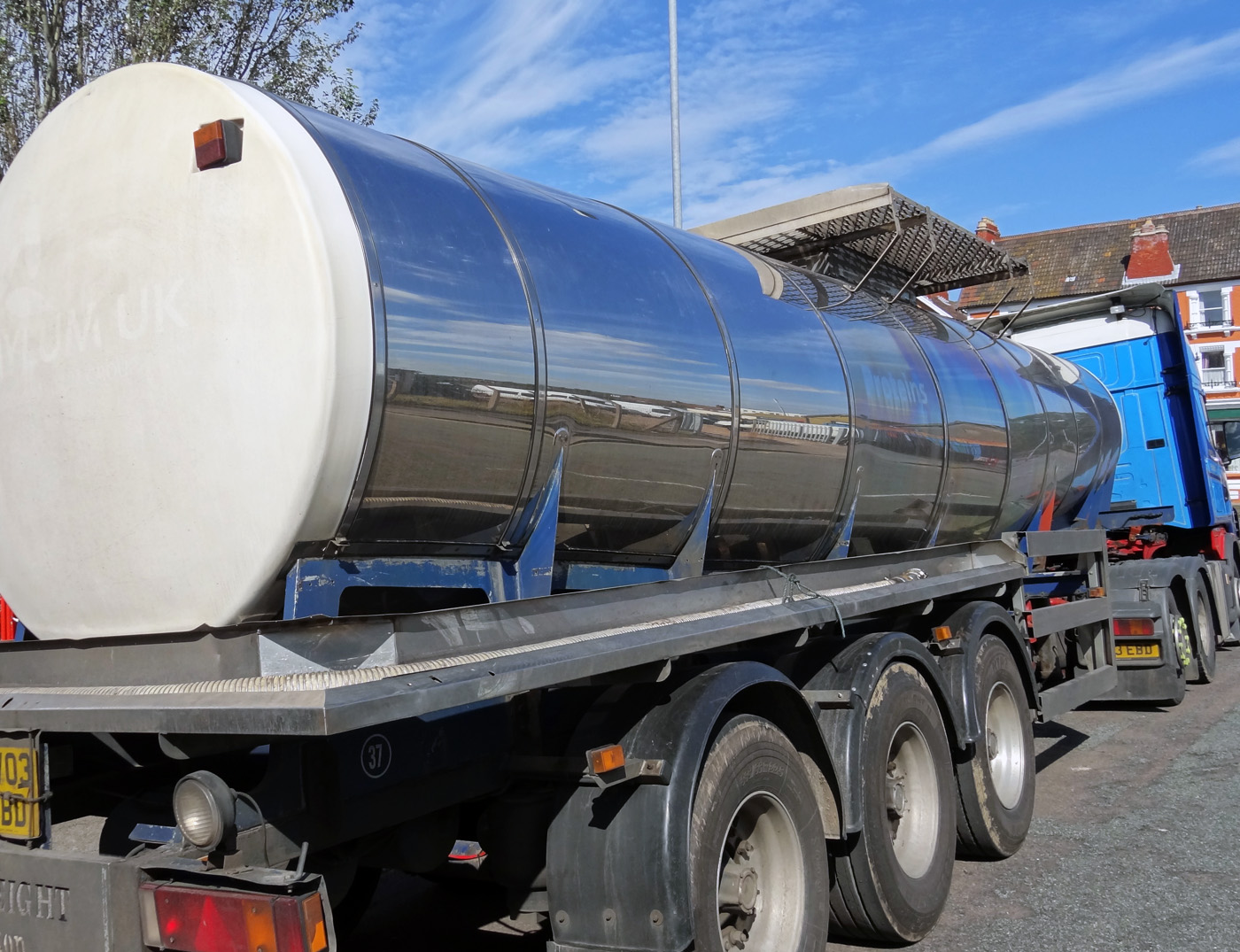 The work is often physically demanding, especially when a large part of the job involves loading and unloading and moving items from the lorry to where the customer wants them.
The work is often physically demanding, especially when a large part of the job involves loading and unloading and moving items from the lorry to where the customer wants them.- Many vehicles are hard and unpleasant to drive, with leased vehicles often low-spec, dirty, uncomfortable and poorly maintained.
- Many of the jobs are agency jobs that do not offer stable employment.
Although pay is higher than in some parts of the labour market where there are shortages, such as social care and hospitality, pay per hour is still relatively poor when compared with many industries which have better conditions of employment.
The future
 The government is allowing more foreign workers into the UK from this month (October); more training places will be offered for potential drivers and the number of driving tests will increase; the government is also encouraging retired drivers or those who have left driving for other jobs to return to the industry.
The government is allowing more foreign workers into the UK from this month (October); more training places will be offered for potential drivers and the number of driving tests will increase; the government is also encouraging retired drivers or those who have left driving for other jobs to return to the industry.
However, there are shortages of drivers in other EU countries and so it will be difficult to attract additional drivers to the UK from the EU. What is more, with wages and working conditions remaining poor and the labour market remaining tight in other sectors, it might be hard to fill new training places and encourage workers to return to driving. Also, with the average age of drivers being 55, it is likely that the outflow of workers from driving jobs could be large in the coming years.
Articles
- Twenty reasons why there is an HGV driver shortage – part one: 1-10
West Country Bylines, Tomasz Oryński (21/9/21)
- Twenty reasons why there is an HGV driver shortage – part 2: reasons 11-20
West Country Bylines, Tomasz Oryński (23/9/21)
- Gas Shortages Awaken Britain to Some Crucial Workers: Truck Drivers
New York Times, Eshe Nelson and Megan Specia (29/9/21)
- Time running out to save UK industry from worker shortages, say business leaders
CNN, Walé Azeez (1/10/21)
- Boris Johnson’s Brexit choices are making Britain’s fuel and food shortages worse
CNN, Hanna Ziady (29/9/21)
- How serious is the shortage of lorry drivers?
BBC News, Reality Check Team (28/9/21)
- Petrol shortage: Is the fuel crisis improving?
BBC News (1/10/21)
- UK visa plan will not fix lorry driver shortage, says boss
BBC News (28/9/21)
- The empty shelves crisis isn’t just down to Covid and Brexit – it’s been decades in the making
The Guardian, Felicity Lawrence (17/9/21)
- Emergency visa scheme extended in major U-turn by Boris Johnson
The Guardian, Rajeev Syal (1/10/21)
- Truck driver shortage won’t be solved by quick fix visas – here are three ways forward
The Conversation, Temidayo Akenroye (27/9/21)
- UK lorry driver shortage a stark example of a wider European problem
Euronews, Luke Hurst and Shona Murray (29/9/21)
- Emergency visas won’t tempt European lorry drivers to UK, say haulage chiefs
The Observer, Jon Henley, Michael Savage and James Tapper (25/9/21)
- Labour shortage threatens to cancel out any Brexit dividend
British Meat Processors Association, Industry News, Peter Hardwick (28/9/21)
- How to control a consumer panic
BBC News. Faisal Islam (28/9/21)
Questions
- Why are the supply of and demand for lorry drivers relatively wage inelastic?
- Use a marginal productivity diagram to explain the current situation in the market for lorry drivers.
- What policy measures could be adopted to increase the supply of lorry drivers? How successful would these be?
- Is it ‘rational’ for consumers to ‘panic buy’ fuel and other products in short supply?
- Find out why there is a shortage of lorry drivers in the EU. Are any of the explanations similar to those in the UK?
- What are the macroeconomic implications of a shortage of lorry drivers and other key workers?
 Global oil prices (Brent crude) reached $128 per barrel on 9 March, a level not seen for 10 years and surpassed only in the run up to the financial crisis in 2008. Oil prices are determined by global demand and supply, and the current surge in prices is no exception.
Global oil prices (Brent crude) reached $128 per barrel on 9 March, a level not seen for 10 years and surpassed only in the run up to the financial crisis in 2008. Oil prices are determined by global demand and supply, and the current surge in prices is no exception. In 2019, oil was typically trading at around $60 to $70 per barrel. It then fell dramatically in early 2020 as the onset of COVID-19 led to a collapse in demand, for both transport and industry. The price fell below $20 in late April (see charts: click here for a PowerPoint).
In 2019, oil was typically trading at around $60 to $70 per barrel. It then fell dramatically in early 2020 as the onset of COVID-19 led to a collapse in demand, for both transport and industry. The price fell below $20 in late April (see charts: click here for a PowerPoint). Then worries began to grow about Russian intentions over Ukraine as Russia embarked on large-scale military exercises close to the border with Ukraine. People increasingly disbelieved Russia’s declarations that it had no intention to invade. Russia is the world’s second biggest producer of oil and people feared that deliberate disruptions to supply by Russia or other countries banning imports of Russian oil would cause supply shortages. Speculation thus drove up the oil price. By 23 February, the day before the Russian invasion of Ukraine, Brent crude had risen to $95.
Then worries began to grow about Russian intentions over Ukraine as Russia embarked on large-scale military exercises close to the border with Ukraine. People increasingly disbelieved Russia’s declarations that it had no intention to invade. Russia is the world’s second biggest producer of oil and people feared that deliberate disruptions to supply by Russia or other countries banning imports of Russian oil would cause supply shortages. Speculation thus drove up the oil price. By 23 February, the day before the Russian invasion of Ukraine, Brent crude had risen to $95. On 8 March, the USA announced that it was banning the import of Russian oil with immediate effect. The same day, the UK announced that it would phase out the import of Russian oil and oil products by the end of 2022.
On 8 March, the USA announced that it was banning the import of Russian oil with immediate effect. The same day, the UK announced that it would phase out the import of Russian oil and oil products by the end of 2022.  Russia is also a major producer of natural gas. The EU is particularly dependent on Russia, which supplies 40% of its natural gas. With Germany halting approval of the major new gas pipeline under the Baltic from Russia to Germany, Nord Stream 2, the price of gas has rocketed. On the day of the invasion, European gas prices rose by over 50%.
Russia is also a major producer of natural gas. The EU is particularly dependent on Russia, which supplies 40% of its natural gas. With Germany halting approval of the major new gas pipeline under the Baltic from Russia to Germany, Nord Stream 2, the price of gas has rocketed. On the day of the invasion, European gas prices rose by over 50%.  The effect of these supply shocks can be illustrated in a simple aggregate demand and supply diagram (see Figure 1), which shows a representative economy that imports energy, grain and other resources. Aggregate demand and short-run aggregate supply are initially given by AD0 and SRAS0. Equilibrium is at point a, with real national income (real GDP) of Y0 and a price index of P0.
The effect of these supply shocks can be illustrated in a simple aggregate demand and supply diagram (see Figure 1), which shows a representative economy that imports energy, grain and other resources. Aggregate demand and short-run aggregate supply are initially given by AD0 and SRAS0. Equilibrium is at point a, with real national income (real GDP) of Y0 and a price index of P0. An expansionary policy, such as increasing bond purchases (quantitative easing) or increasing government spending, may help to avoid recession (at least temporarily), but will only exacerbate inflation. In Figure 2, aggregate demand shifts to AD2. Equilibrium moves to point c. Real GDP returns to Y0 (at least temporarily) but the price level rises further, to P2. (Click
An expansionary policy, such as increasing bond purchases (quantitative easing) or increasing government spending, may help to avoid recession (at least temporarily), but will only exacerbate inflation. In Figure 2, aggregate demand shifts to AD2. Equilibrium moves to point c. Real GDP returns to Y0 (at least temporarily) but the price level rises further, to P2. (Click  With the onset of the pandemic in early 2020, stock markets around the world fell dramatically, with many indices falling by 30% or more. In the USA, the Dow Jones fell by 37% and the Nasdaq fell by 30%. In the UK, the FTSE 100 fell by 33% and the FTSE 250 by 41%.
With the onset of the pandemic in early 2020, stock markets around the world fell dramatically, with many indices falling by 30% or more. In the USA, the Dow Jones fell by 37% and the Nasdaq fell by 30%. In the UK, the FTSE 100 fell by 33% and the FTSE 250 by 41%.
 The key question is what will investors believe. If they believe that share prices will continue to fall they are likely to sell. This has happened since early January, especially in the USA and especially with stocks in the high-tech sector – such stocks being heavily represented in the Nasdaq composite, a broad-based index that includes over 2500 of the equities listed on the Nasdaq stock exchange. From 3 January to 18 February the index fell from 15 833 to 13 548, a fall of 14.4%. But will this fall be seen as enough to reflect the current economic and financial climate. If so, it could fluctuate around this sort of level.
The key question is what will investors believe. If they believe that share prices will continue to fall they are likely to sell. This has happened since early January, especially in the USA and especially with stocks in the high-tech sector – such stocks being heavily represented in the Nasdaq composite, a broad-based index that includes over 2500 of the equities listed on the Nasdaq stock exchange. From 3 January to 18 February the index fell from 15 833 to 13 548, a fall of 14.4%. But will this fall be seen as enough to reflect the current economic and financial climate. If so, it could fluctuate around this sort of level. But a lot of this is second-guessing what other people will do – known as a
But a lot of this is second-guessing what other people will do – known as a 
 Inflation has been rising around the world as a combination of a recovery in demand and supply-chain issues have resulted in aggregate demand exceeding aggregate supply. Annual consumer price inflation at the beginning of 2022 is around 2.5% in China, 3.5% in Sweden, 5% in the eurozone, Canada and India, 6% in the UK and South Africa, 7% in the USA and 7.5% in Mexico. In each case it is forecast to go a little higher before falling back again.
Inflation has been rising around the world as a combination of a recovery in demand and supply-chain issues have resulted in aggregate demand exceeding aggregate supply. Annual consumer price inflation at the beginning of 2022 is around 2.5% in China, 3.5% in Sweden, 5% in the eurozone, Canada and India, 6% in the UK and South Africa, 7% in the USA and 7.5% in Mexico. In each case it is forecast to go a little higher before falling back again. Why is Turkey’s inflation so much higher than in most developed and emerging economies and why has it risen so rapidly? The answer is that aggregate demand has been excessively boosted – well ahead of the ability of supply to respond. This has driven inflation expectations.
Why is Turkey’s inflation so much higher than in most developed and emerging economies and why has it risen so rapidly? The answer is that aggregate demand has been excessively boosted – well ahead of the ability of supply to respond. This has driven inflation expectations.
 Long queues at petrol pumps, with many filling stations running out of fuel; fears of shortages of food and various other items in supermarkets; orders by shops and warehouses unfilled or delayed. These have been some of the headlines in the UK in recent days.
Long queues at petrol pumps, with many filling stations running out of fuel; fears of shortages of food and various other items in supermarkets; orders by shops and warehouses unfilled or delayed. These have been some of the headlines in the UK in recent days.  With Brexit, many EU workers left the UK, finding life and working conditions more conducive in the EU. Many EU drivers had faced discrimination and felt that they were not welcome in the UK. It has been difficult finding replacement drivers from the EU as the UK’s immigration system, which now applies to the EU as well as other countries, prioritises workers who are classified as high-skilled, and these do not include lorry drivers.
With Brexit, many EU workers left the UK, finding life and working conditions more conducive in the EU. Many EU drivers had faced discrimination and felt that they were not welcome in the UK. It has been difficult finding replacement drivers from the EU as the UK’s immigration system, which now applies to the EU as well as other countries, prioritises workers who are classified as high-skilled, and these do not include lorry drivers. Then there is a decline in the system known as ‘cabotage’. This is where an EU driver delivers from the EU to destination A in the UK and takes back a load to the EU from destination B in the UK. To avoid having to travel empty between the two UK destinations, the driver could pick up a load to take from A to B. With a fall in imports and exports from and to the EU following Brexit, there are fewer EU lorries on UK roads. This means that there is now less capacity for transporting loads within the UK.
Then there is a decline in the system known as ‘cabotage’. This is where an EU driver delivers from the EU to destination A in the UK and takes back a load to the EU from destination B in the UK. To avoid having to travel empty between the two UK destinations, the driver could pick up a load to take from A to B. With a fall in imports and exports from and to the EU following Brexit, there are fewer EU lorries on UK roads. This means that there is now less capacity for transporting loads within the UK. The pandemic led to fewer HGV driver tests, with 25 000 fewer candidates passing their test in 2020 than in 2019. It takes time to train new drivers and then to test them. However, even if there had been no reduction in HGV drivers passing their tests, there would still be a significant shortage of qualified drivers.
The pandemic led to fewer HGV driver tests, with 25 000 fewer candidates passing their test in 2020 than in 2019. It takes time to train new drivers and then to test them. However, even if there had been no reduction in HGV drivers passing their tests, there would still be a significant shortage of qualified drivers. Driving jobs are often very tightly controlled, with computer monitoring and little freedom for the driver. Some cabs have cameras aimed at the drivers so that they can be constantly monitored.
Driving jobs are often very tightly controlled, with computer monitoring and little freedom for the driver. Some cabs have cameras aimed at the drivers so that they can be constantly monitored. Rest and refreshment facilities are often very poor in the UK and generally much worse than in the EU. In the EU, motorway service areas have better parking, toilets, showers and shops. Restaurants are better and cheaper. Dedicated truck stops have supermarkets, laundrettes, showers or even open-air gyms dedicated to making drivers’ lives easier and more pleasant. The UK by contrast often has very poor facilities. Unlike in most EU motorway services, drivers have to pay to park and are faced with poor toilet and eating facilities. ‘Meanwhile, a typical British truck stop is some dusty yard full of potholes on the side of some industrial estate with a portaloo and a “greasy spoon” burger van parked next to it.’
Rest and refreshment facilities are often very poor in the UK and generally much worse than in the EU. In the EU, motorway service areas have better parking, toilets, showers and shops. Restaurants are better and cheaper. Dedicated truck stops have supermarkets, laundrettes, showers or even open-air gyms dedicated to making drivers’ lives easier and more pleasant. The UK by contrast often has very poor facilities. Unlike in most EU motorway services, drivers have to pay to park and are faced with poor toilet and eating facilities. ‘Meanwhile, a typical British truck stop is some dusty yard full of potholes on the side of some industrial estate with a portaloo and a “greasy spoon” burger van parked next to it.’ The work is often physically demanding, especially when a large part of the job involves loading and unloading and moving items from the lorry to where the customer wants them.
The work is often physically demanding, especially when a large part of the job involves loading and unloading and moving items from the lorry to where the customer wants them. The government is allowing more foreign workers into the UK from this month (October); more training places will be offered for potential drivers and the number of driving tests will increase; the government is also encouraging retired drivers or those who have left driving for other jobs to return to the industry.
The government is allowing more foreign workers into the UK from this month (October); more training places will be offered for potential drivers and the number of driving tests will increase; the government is also encouraging retired drivers or those who have left driving for other jobs to return to the industry.